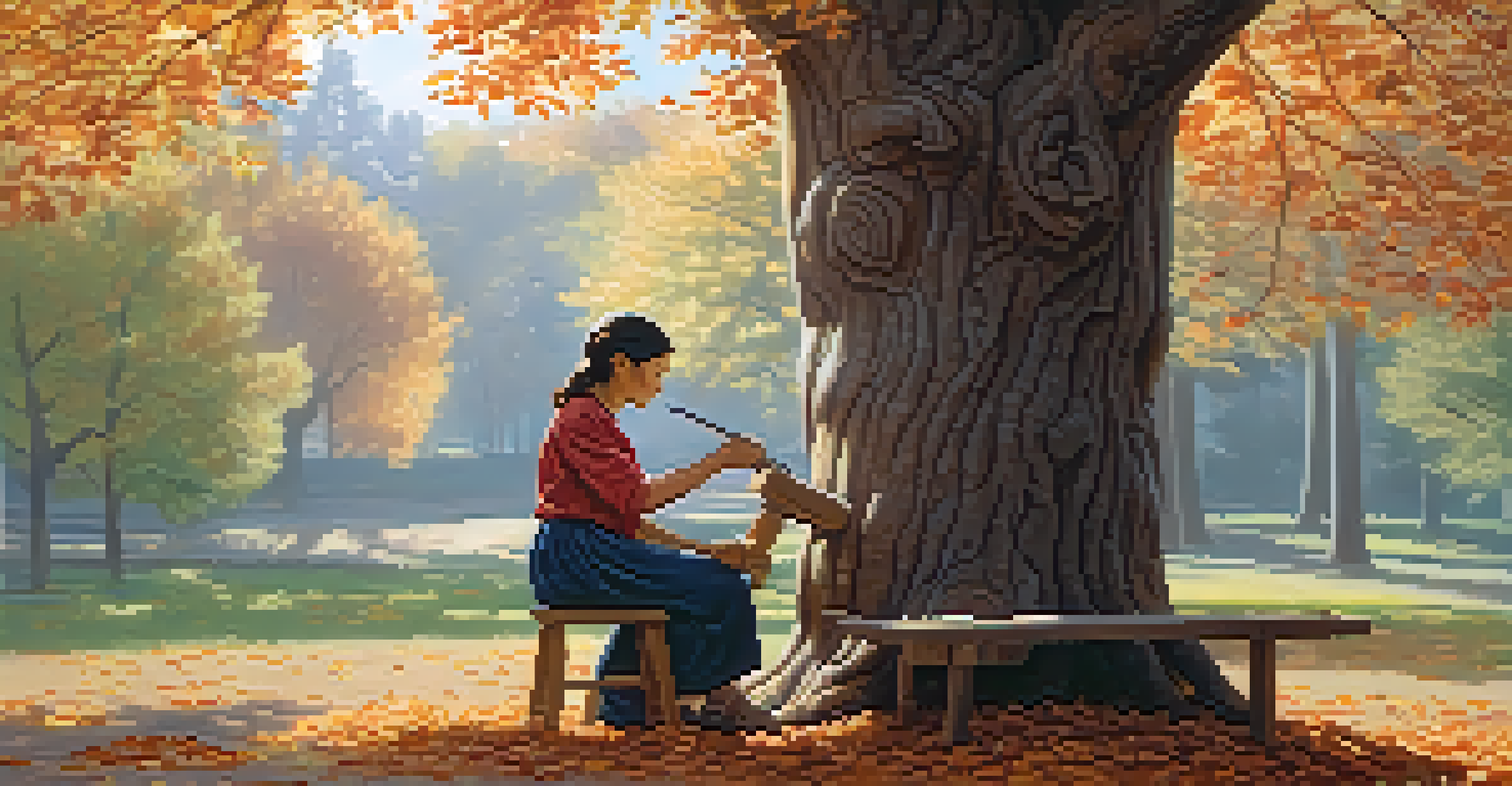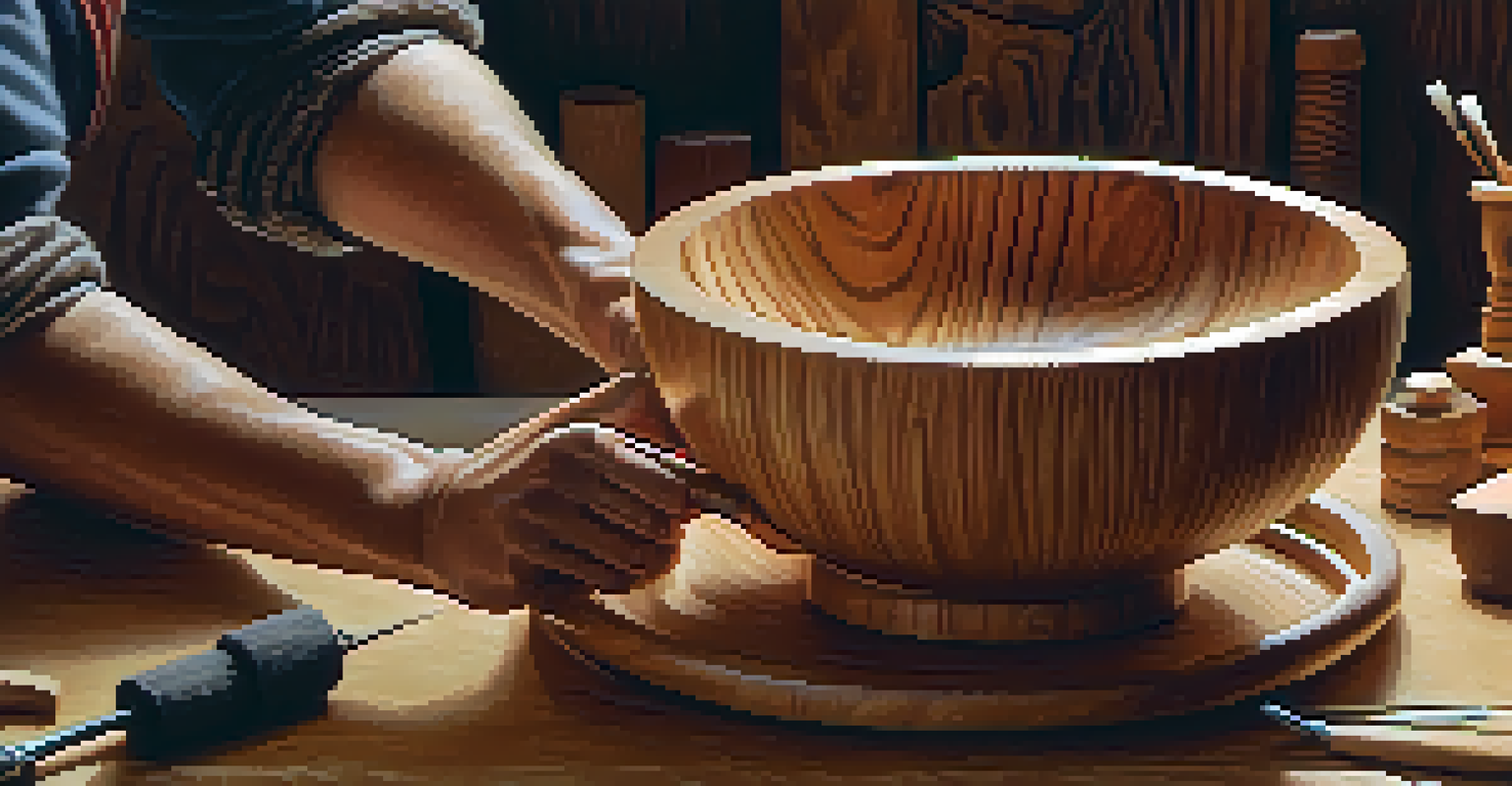The Connection Between Wood Carving and Meditation Benefits

Understanding Wood Carving as a Form of Art Therapy
Wood carving is not just a craft; it's a powerful form of art therapy that promotes mental well-being. Engaging in this creative process allows individuals to express themselves, reducing stress and anxiety. As hands work with wood, the mind often enters a meditative state, making it a perfect outlet for emotional release.
Art is not what you see, but what you make others see.
The rhythmic motions of carving can be likened to mindfulness meditation, where focus is placed on the present moment. This practice encourages individuals to let go of distracting thoughts, fostering a sense of calm. Just like meditation, wood carving can lead to a deeper connection with oneself and the surrounding environment.
Furthermore, the tactile nature of wood carving provides sensory input that enhances this meditative experience. The feel of the wood, the sound of tools, and the sight of shapes emerging can all contribute to a heightened state of awareness. In this way, wood carving becomes a transformative journey into mindfulness.
The Mindfulness Connection: Carving and Presence
Mindfulness is all about being present in the moment, and wood carving naturally encourages this practice. When you focus on the grain of the wood or the angle of your chisel, distractions fade away. This immersion in the task at hand can lead to a state of flow, where time seems to stand still.

Similar to meditation, where the breath is a focal point, wood carving provides a tangible focus that anchors the mind. Each stroke of the tool can serve as a reminder to return to the present, making it a meditative practice in its own right. This connection can enhance emotional regulation and reduce feelings of overwhelm.
Wood Carving as Art Therapy
Engaging in wood carving promotes mental well-being by allowing for self-expression and reducing stress.
Moreover, the satisfaction of creating something beautiful can boost self-esteem and foster a sense of accomplishment. These positive feelings can further deepen the meditative effects of carving, making it not just a hobby, but a holistic approach to mental wellness.
Physical Benefits: How Carving Affects the Body
While meditation is often associated with mental health, it’s essential to recognize the physical benefits that come with wood carving as well. The act of carving involves repetitive motions that can improve fine motor skills and hand-eye coordination. This physical engagement can be incredibly grounding, connecting the mind and body.
The best way to find yourself is to lose yourself in the service of others.
Additionally, the focused nature of carving can lead to improved posture and muscle strength. As you carve, you're likely to adopt a stable and supportive position, which can help alleviate tension in the body. In this way, wood carving promotes not only mental clarity but also physical well-being.
Moreover, engaging in a physical activity like carving can release endorphins, the body’s natural stress relievers. This means that through carving, not only does one find a mental escape, but they also reap the benefits of a happier, healthier body.
Creating a Personal Sanctuary with Wood Carving
One of the most beautiful aspects of wood carving is its ability to create a personal sanctuary. By carving your own pieces, you not only express your creativity but also create items that resonate with your spirit. This personal connection can turn a simple object into a meditative focal point.
Imagine a beautifully carved wooden bowl or a delicate figurine that holds special meaning for you. Each time you see or touch these pieces, they can serve as a reminder of your mindfulness practice. This connection enhances the meditative experience, fostering a deeper appreciation for the artistry involved.
Mindfulness Through Carving
The focused nature of wood carving encourages mindfulness, enhancing emotional regulation and creating a sense of flow.
Furthermore, dedicating a space for your carving can transform your environment into a calming oasis. Surrounded by your tools and creations, you can find solace and inspiration, making your carving sessions not just a hobby but a cherished ritual of self-care.
The Role of Nature in Wood Carving and Meditation
Nature plays a significant role in both wood carving and meditation. The materials used in carving often come from trees, which have their own stories and energy. This connection to nature can deepen the meditative experience, encouraging a sense of gratitude and respect for the environment.
Being outdoors while carving can enhance this connection even further. The sights and sounds of nature can provide a peaceful backdrop, allowing for a more profound state of mindfulness. As you carve, the gentle rustling of leaves or the chirping of birds can serve as a soothing soundtrack, grounding you in the moment.
Moreover, the act of selecting the wood itself can become a meditative practice. Choosing a piece of wood, feeling its texture, and observing its natural beauty invites a moment of reflection and intention, making the entire process a celebration of nature's gifts.
Building Community Through Wood Carving
Wood carving can also foster community and connection, which are vital for mental health. Joining a carving group or workshop not only allows individuals to learn new skills but also to share experiences and stories. This sense of belonging can enhance the meditative benefits of carving by providing support and encouragement.
In these community settings, participants often share their challenges and triumphs, creating a safe space for personal growth. The bonding that occurs over shared interests can lead to meaningful relationships, further enriching the overall experience of wood carving. This collaborative spirit can transform solitary practice into a collective journey.
Community and Connection
Joining wood carving groups fosters community and support, enriching the meditative experience through shared stories and encouragement.
Additionally, participating in community events or exhibitions allows carvers to showcase their work, which can be incredibly fulfilling. Sharing your creations with others not only builds confidence but also creates a dialogue about the meditative aspects of carving, promoting mindfulness among peers.
Tips for Integrating Wood Carving into Your Mindfulness Practice
If you're looking to integrate wood carving into your mindfulness practice, start by creating a dedicated space for your work. A serene environment can enhance focus and relaxation, allowing you to fully immerse yourself in the process. Consider adding calming elements like soft lighting or soothing music to elevate your experience.
Next, approach each carving session with intention. Set aside time specifically for carving, treating it as a meditative ritual rather than just a task. Before you begin, take a few moments to breathe deeply, clearing your mind and setting a positive intention for your session.

Lastly, embrace the process rather than focusing solely on the outcome. Each carving is a journey, and allowing yourself to be present in that journey can lead to profound insights and joy. Remember, the beauty of wood carving lies not just in the finished piece but in the meditative experience it provides.